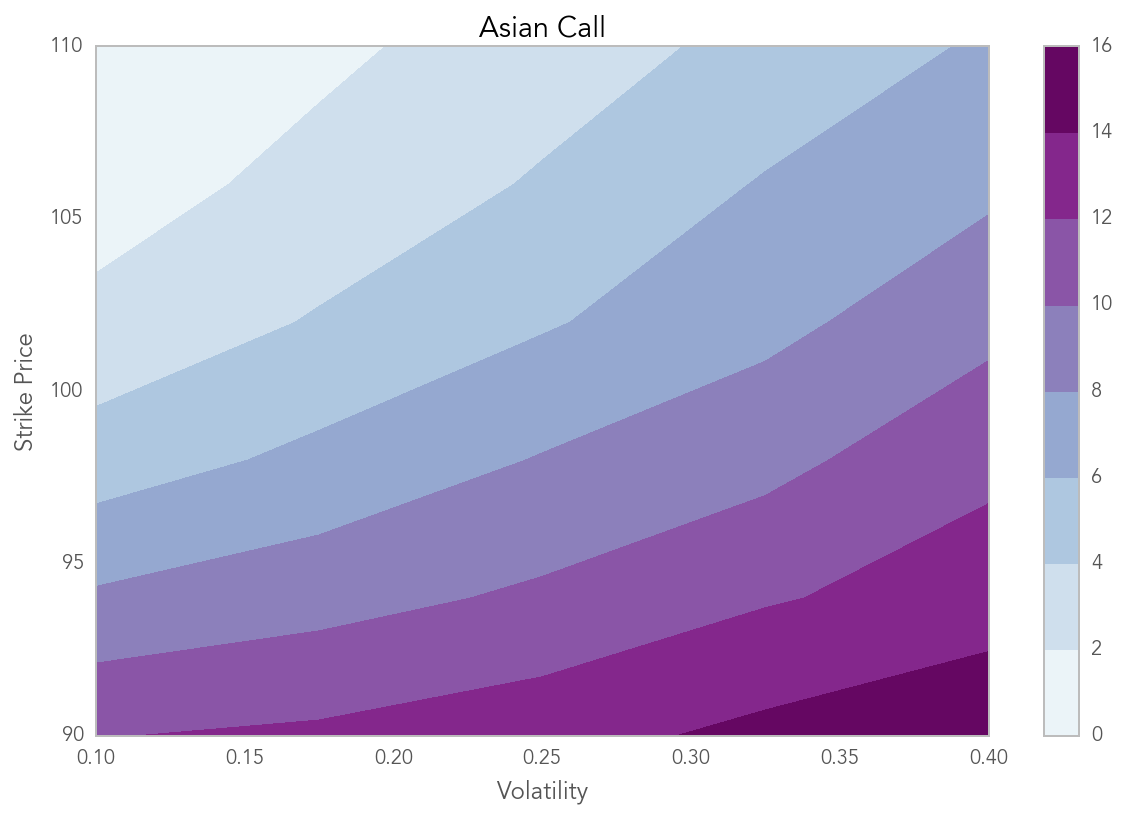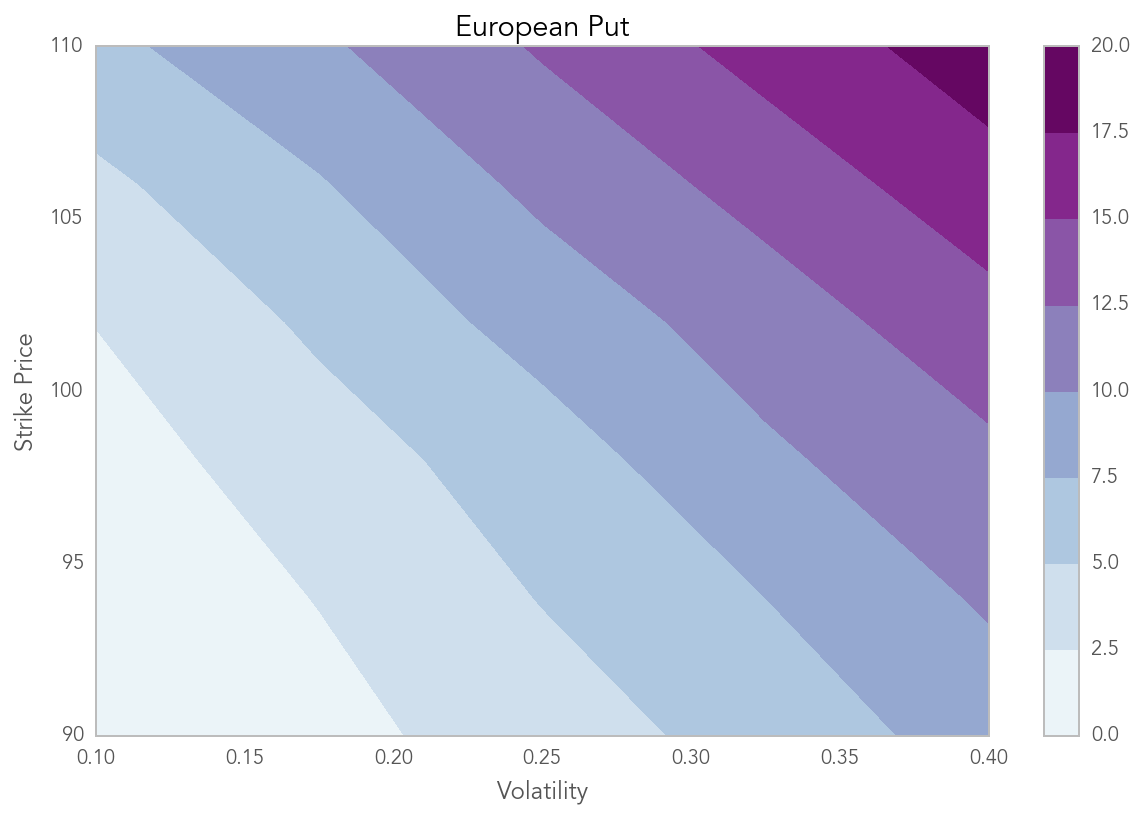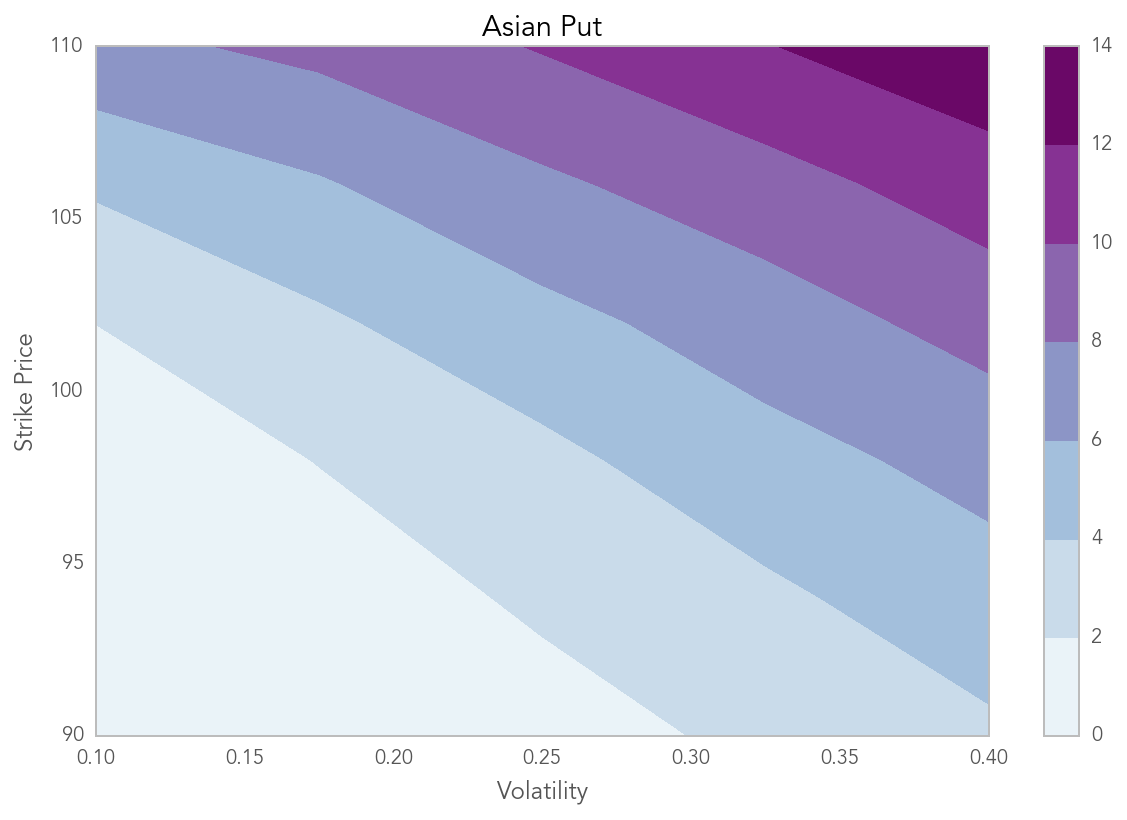Parallel Monto-Carlo options pricing¶
This notebook shows how to use ipyparallel to do Monte-Carlo options pricing in parallel. We will compute the price of a large number of options for different strike prices and volatilities.
Problem setup¶
[1]:
%matplotlib inline
import matplotlib.pyplot as plt
[2]:
import sys
import time
import numpy as np
Here are the basic parameters for our computation.
[3]:
price = 100.0 # Initial price
rate = 0.05 # Interest rate
days = 260 # Days to expiration
paths = 10000 # Number of MC paths
n_strikes = 6 # Number of strike values
min_strike = 90.0 # Min strike price
max_strike = 110.0 # Max strike price
n_sigmas = 5 # Number of volatility values
min_sigma = 0.1 # Min volatility
max_sigma = 0.4 # Max volatility
[4]:
strike_vals = np.linspace(min_strike, max_strike, n_strikes)
sigma_vals = np.linspace(min_sigma, max_sigma, n_sigmas)
[5]:
from __future__ import print_function # legacy Python support
print("Strike prices: ", strike_vals)
print("Volatilities: ", sigma_vals)
Strike prices: [ 90. 94. 98. 102. 106. 110.]
Volatilities: [ 0.1 0.175 0.25 0.325 0.4 ]
Monte-Carlo option pricing function¶
The following function computes the price of a single option. It returns the call and put prices for both European and Asian style options.
[6]:
def price_option(S=100.0, K=100.0, sigma=0.25, r=0.05, days=260, paths=10000):
"""
Price European and Asian options using a Monte Carlo method.
Parameters
----------
S : float
The initial price of the stock.
K : float
The strike price of the option.
sigma : float
The volatility of the stock.
r : float
The risk free interest rate.
days : int
The number of days until the option expires.
paths : int
The number of Monte Carlo paths used to price the option.
Returns
-------
A tuple of (E. call, E. put, A. call, A. put) option prices.
"""
import numpy as np
from math import exp,sqrt
h = 1.0/days
const1 = exp((r-0.5*sigma**2)*h)
const2 = sigma*sqrt(h)
stock_price = S*np.ones(paths, dtype='float64')
stock_price_sum = np.zeros(paths, dtype='float64')
for j in range(days):
growth_factor = const1*np.exp(const2*np.random.standard_normal(paths))
stock_price = stock_price*growth_factor
stock_price_sum = stock_price_sum + stock_price
stock_price_avg = stock_price_sum/days
zeros = np.zeros(paths, dtype='float64')
r_factor = exp(-r*h*days)
euro_put = r_factor*np.mean(np.maximum(zeros, K-stock_price))
asian_put = r_factor*np.mean(np.maximum(zeros, K-stock_price_avg))
euro_call = r_factor*np.mean(np.maximum(zeros, stock_price-K))
asian_call = r_factor*np.mean(np.maximum(zeros, stock_price_avg-K))
return (euro_call, euro_put, asian_call, asian_put)
We can time a single call of this function using the %timeit magic:
[7]:
%time result = price_option(S=100.0, K=100.0, sigma=0.25, r=0.05, days=260, paths=10000)
result
CPU times: user 174 ms, sys: 5.96 ms, total: 180 ms
Wall time: 211 ms
[7]:
(12.166236181100073,
7.6440122060909745,
6.8409606562778666,
4.4639448434953621)
Parallel computation across strike prices and volatilities¶
The Client is used to setup the calculation and works with all engines.
[8]:
import ipyparallel as ipp
rc = ipp.Client()
A LoadBalancedView is an interface to the engines that provides dynamic load balancing at the expense of not knowing which engine will execute the code.
[9]:
view = rc.load_balanced_view()
Submit tasks for each (strike, sigma) pair. Again, we use the %%timeit magic to time the entire computation.
[10]:
async_results = []
[11]:
%%time
for strike in strike_vals:
for sigma in sigma_vals:
# This line submits the tasks for parallel computation.
ar = view.apply_async(price_option, price, strike, sigma, rate, days, paths)
async_results.append(ar)
rc.wait(async_results) # Wait until all tasks are done.
CPU times: user 127 ms, sys: 15.7 ms, total: 143 ms
Wall time: 1.97 s
[12]:
len(async_results)
[12]:
30
Process and visualize results¶
Retrieve the results using the get method:
[13]:
results = [ar.get() for ar in async_results]
Assemble the result into a structured NumPy array.
[14]:
prices = np.empty(n_strikes*n_sigmas,
dtype=[('ecall',float),('eput',float),('acall',float),('aput',float)]
)
for i, price in enumerate(results):
prices[i] = tuple(price)
prices.shape = (n_strikes, n_sigmas)
Plot the value of the European call in (volatility, strike) space.
[15]:
plt.figure()
plt.contourf(sigma_vals, strike_vals, prices['ecall'])
plt.axis('tight')
plt.colorbar()
plt.title('European Call')
plt.xlabel("Volatility")
plt.ylabel("Strike Price")
[15]:
<matplotlib.text.Text at 0x106036470>

Plot the value of the Asian call in (volatility, strike) space.
[16]:
plt.figure()
plt.contourf(sigma_vals, strike_vals, prices['acall'])
plt.axis('tight')
plt.colorbar()
plt.title("Asian Call")
plt.xlabel("Volatility")
plt.ylabel("Strike Price")
[16]:
<matplotlib.text.Text at 0x1062d27f0>

Plot the value of the European put in (volatility, strike) space.
[17]:
plt.figure()
plt.contourf(sigma_vals, strike_vals, prices['eput'])
plt.axis('tight')
plt.colorbar()
plt.title("European Put")
plt.xlabel("Volatility")
plt.ylabel("Strike Price")
[17]:
<matplotlib.text.Text at 0x106c0c748>

Plot the value of the Asian put in (volatility, strike) space.
[18]:
plt.figure()
plt.contourf(sigma_vals, strike_vals, prices['aput'])
plt.axis('tight')
plt.colorbar()
plt.title("Asian Put")
plt.xlabel("Volatility")
plt.ylabel("Strike Price")
[18]:
<matplotlib.text.Text at 0x1078690b8>
